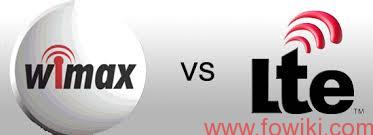1. Comparison of LTE Rel-8 and WiMAX 802.16e
There are a lot of commonalities between LTE Rel-8 and WiMAX, but there are some notable differences. For

example:
- LTE uses SC-FDMA for the uplink, whereas mobile WiMAX uses OFDMA. LTE user equipment (SC-FDMA) has a lower peak-to-average-power ratio when compared to mobile WiMAX user equipment (OFDMA), which translates into longer battery life for LTE user equipment
- LTE networks can provide communication services at a higher mobility (up to 350km/hr) than mobile WiMAX (up to 120km/hr)
- internetworking between W-CDMA and LTE or between HSPA and LTE is easier than with mobile WiMAX.
2. Comparison of LTE-Advanced and WiMAX 802.16m
The aim of LTE-Advanced and IEEE 802.16m WiMAX (R2.0) is to meet or exceed the IMTAdvanced requirements. Some key features of IMT-Advanced are worldwide roaming, compatibility of services, interworking with other radio access systems and enhanced peak data rates. The shared channel downlink peak rate is expected to be 1000Mbps and 100Mbps in lowand high-mobility scenarios, respectively. It is expected that WiMAX R2.0 and LTE-Advanced will be deployed in late 2012 at the earliest. WiMAX R2.0 could potentially be deployed first, as work on IEEE 802.16m started earlier than LTE-Advanced.
At this stage, it is not possible to make a comprehensive comparison of these technologies, because the standards have not yet been finalised. However, the differences between LTEAdvanced and 802.16m WiMAX are most likely to be the same as the previous releases.
3. FD-LTE and TD-LTE
Traditional 3GPP mobile network operators have generally accepted FD-LTE as their evolution path towards 4G because the existing 3GPP infrastructure is based on FDD mode. This explains why the current FD-LTE ecosystem is bigger than that of TD-LTE.
China Mobile has adopted TD-LTE as its 4G technology because of its unique evolution path in the industry from GSM to TD-SCDMA and then to TD-LTE, which means that China Mobile’s existing network infrastructure already operates in TDD mode. Following this announcement, other mobile network operators have considered TD-LTE as a viable option for their 4G strategies.
Greenfield and existing WiMAX operators are also giving more attention to TD-LTE than to FDLTE.The potential cost-effective equipment, and the greater availability and lower cost of TDD spectrum make TD-LTE an attractive option for greenfield operators. Current WiMAX spectrum bands and the ability to provide a smooth migration from existing WiMAX infrastructure to TD-LTE also make TD-LTE an attractive option for existing WiMAX operators. Existing WiMAX
operators such as P1 in Malaysia and Yota in Russia have announced plans for migration to TD-LTE.
In India, despite having had 2.3GHz spectrum for almost 18 months, the operators are understood to be preparing to launch TD-LTE rather than WiMAX. Increasingly, traditional 3GPP operators are also considering TD-LTE; for example, E-Plus in Germany and Hi3G in Denmark and Sweden have been considering whether to use unpaired spectrum to deploy TD-LTE.
4. Conclusion
There are more similarities than differences between WiMAX and LTE technologies. However, there is a general consensus among the major mobile operators that WiMAX is a more complex technology to implement than LTE. For example, the subcarrier spacing option for LTE is fixed and for WiMAX it is variable, which makes the latter more complex to design and implement.
Due to the stronger backing of LTE by operators, the volume of end-user devices is expected to be much higher for LTE than for WiMAX. LTE is regarded as the natural evolution path for all mobile networks employing 3GPP technologies. Another factor that favours LTE over WiMAX is the roaming issue between WiMAX devices and 3GPP networks (GSM, W-CDMA and HSPA) and vice-versa. This is evidenced by a number of WiMAX service providers and vendors that have started to buy into the potential benefits of the economies of scale offered by LTE. Yota, a
WiMAX operator in Russia, announced its intention in May 2010 to commence roll-out of an LTE network, citing the global shift towards LTE by operators and vendors as its reason for the switch to LTE and adding that its delay in deploying LTE had been due to the immaturity of the technology.
LTE has also gained support in the USA. For example, Clearwire conducted TD-LTE trials from late 2010 to early 2011. The operator had previously been technology agnostic, and initially deployed WiMAX to meet the immediate subscriber demand for ubiquitous and affordable mobile broadband services. Clearwire has also restated its commitment to WiMAX, stating that it is “conducting LTE technical trials to determine how it could potentially add LTE technology to coexist with WiMAX”.
In summary, both LTE and WiMAX are future-proofed technologies. However, mobile network operators have shown more confidence in LTE, and particularly TD-LTE, because it provides asymmetrical mobile broadband, which is better aligned to end-user expectations.